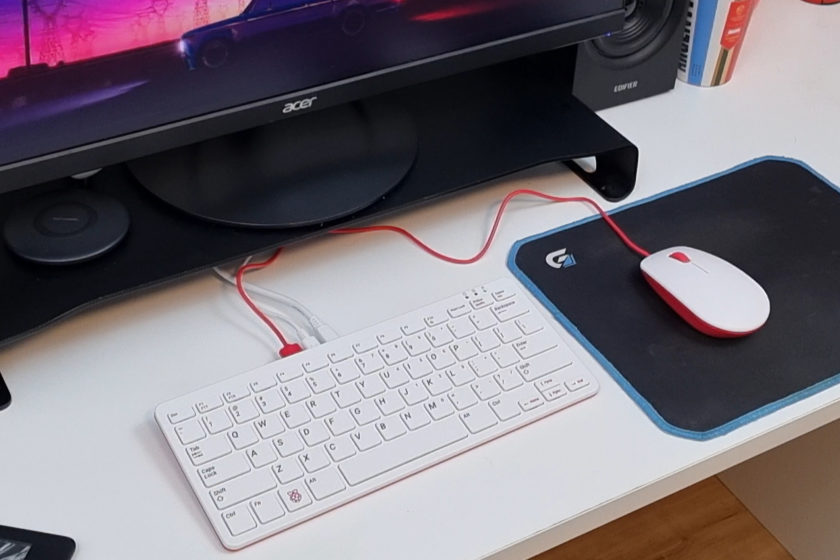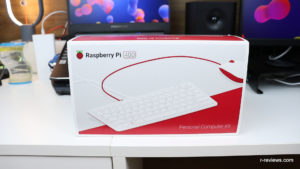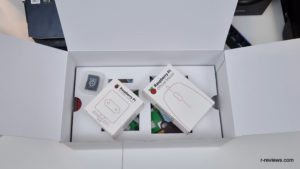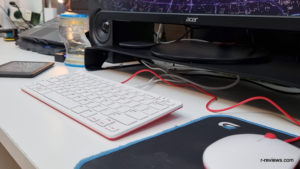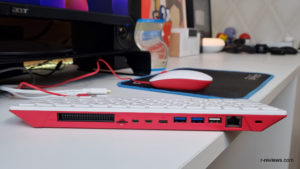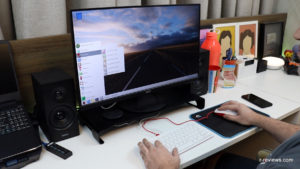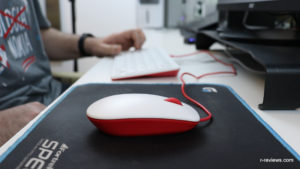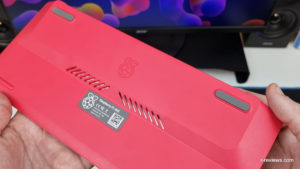Where to buy? Ali Express (HERE or HERE)
I’ve had a few different versions of the Raspberry Pi, the so famous computers that boil down to tiny boards. In addition to the low price and versatility, I’ve always admired them for being surprisingly robust and well-built. That’s why I was so excited when I heard about the Raspberry Pi 400, the most home-PC-like version so far.
In this case, the manufacturer built a Pi 4 variant inside of a nice keyboard, which can be sold separately or in a combo that includes official mouse, cables, micro SD card and illustrated manual. This was the kit I imported from China and it cost me something around 150 USD.
The packaging is beautiful, it even looks like a product made by a veteran company in that regard. I chose an american standard keyboard with european power adapter, because it’s fully compatible with brazilian power sockets – that choice could be made in the store.
The keyboard is all plastic, but it has a solid structure, which doesn’t bend while I’m typing. Its feedback is something in between clickable and soft, with a somewhat shallow depth. Coming from my daily mechanical keyboard, it took me a while to get used to it and stop making typos. I faced one or two days of learning.
On the back of the piece we find all the connections: USB-C for power, USB-A, micro HDMI (the included cable has one end in this format), micro SD card slot, as well as the classic pins for connecting other hardware. Dual Band Wi-Fi and Bluetooth are supported. The mouse is also plugged at the back – it looks good and gets the job done, but it’s a very simple optical USB model with a rubberized scroll wheel.
As I said before, the set is powered by the Broadcom BCM2711 processor, a quad-core Cortex-A72 also found in the Raspberry Pi 4, although it’s overclocked to 1.8GHZ. There are 4GB of RAM and they include a 16GB micro SD card with the Raspberry Pi OS pre-installed – it’s a Linux variant formerly known as Raspbian. Just plug in the USB-C power and the system boots up.
And this is the point where I start to answer my main question about the Pi 400 before buying it: does it work well as a home computer for casual use?
The Raspberry Pi OS home screen is user-friendly: we have a regular desktop and a top bar that I’ve brought down, leaving it as in Windows 10. I noticed that the image scale was a bit strange after the first boot, as if the resolution was higher than my monitor’s. A quick search in web forums and I found that the solution was easy, I just needed to change a simple option in the “start menu”.
Speaking of that menu, when I browsed it, I realized that the system already includes some very useful pre-installed applications, especially the Libre Office package. The softwares worked great for me, with very little learning curve for a long-time Microsoft Office user. I noticed that, when opening Word files with lots of text, tables and sophisticated formatting, Libre Office had problems keeping everything as original. It’s an inconvenience for which there is no solution, I guess. Anyway, for those starting from scratch with the Pi 400, there shouldn’t be any particular issue.
So how’s performance in everyday life? I’d say regular to good. When browsing the web with Chromium, it’s noticeable that heavy pages of large portals, or even the YouTube home, they take something like 10 seconds longer than usual to load. Scrolling up and down on these sites is also a bit less fluid. When opening a YouTube video, the initial loading may require a second or two, although they run smoothly once they start playing. I watched a lot of HD content on YouTube and Netflix with no problems.
General performance of the operating system is clean, it even surprised me. Overall, this struck me as a perfectly usable computer for web browsing, text editing and similar tasks. I recently tested a laptop with Celeron processor, eMMC storage and Windows 10, where the results were similar to what I found on the Pi 400. When I compared it to a Moto G100 (Snapdragon 870) in desktop mode (called Ready For), the Pi lost in speed, but took the lead in usability, since it delivers a more traditional PC experience.
The device remained very stable during my tests, with 100% silent operation and little or no heating – I noticed warm spots under the keyboard, as area that doesn’t have any direct impact on the user. In addition, I thought the set looked really good on my desk, even with the black pieces that predominate in my setup. I just missed a P2 (3.5 mm) input on the keyboard’s rear panel. Since there isn’t one, I had to use my monitor’s output to connect my headphones.
My final impression is that the Raspberry Pi 400 provides a decent home computer experience. The good results in basic tasks along with the low power consumption, made me satisfied with the purchase. After a while, I plan to buy another micro SD card to install classic video games emulators and be able to play some classics in my spare time. I’d say that, for those who have the exact idea of what they are taking (a simple machine), this one is a good buy.

